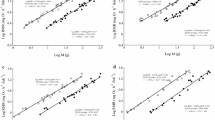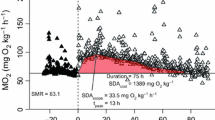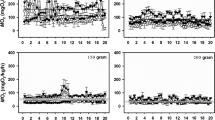Abstract
Food consumption, standard metabolism, and growth of juvenile snakehead, Channa striatus, a cannibalistic and air-breathing fish were measured at 24–26 °C under controlled laboratory condition. Snakehead weighing 3.2–29.5 g were evaluated, and were fed smaller snakehead. Based on our observations, we determined bioenergetics relationships between specific food consumption, metabolic rates, and body weight. These values, along with other published parameter values allowed us to construct a bioenergetics model for snakehead. We then verified our model with growth and food consumption measurements from an independent feeding trial. Predicted fish growth closely matched observed growth. Our model underestimated cumulative food consumption when a constant activity value was used, but consumption estimates improved when we used non-constant activity values (1-5 times of standard metabolism). Predicted fish maintenance ration was 1.7% of body weight per day. Food conversion efficiency was greatest (0.59) when fed 2% body weight daily, but declined when daily consumption exceeded 6% body weight. This model provides a useful approach for assessing food requirements of snakehead under controlled condition.
Similar content being viewed by others
References cited
Beamish, F.W.H. 1964. Influence of starvation on standard and routine oxygen consumption. Trans. Amer. Fish. Soc. 93: 103–107.
Beamish, F.W.H. 1972. Ration size and digestion in largemouth bass Micropterus salmoides L. Can. J. Zool. 50: 153–164.
Beamish, F.W.H. 1974. Apparent specific dynamic action of largemouth bass, Micropterus salmonides. J. Fish Res. Board Can. 31: 1763–1769.
Boisclair, D. & W.C. Leggett. 1989. The importance of activity in bioenergetics models applied to actively foraging fishes. Can. J. Fish. Aquat. Sci. 46: 1859–1867.
Boisclair, D. & P. Sirois. 1993. Testing assumptions of fish bioenergetics models by direct estimating of growth, consumption and activity rates. Trans. Amer. Fish. Soc. 122: 784–796.
Brandt, S.B. & K.J. Hartman. 1993. Innovative approaches with bioenergetics models: future applications to fish ecology and management. Trans. Amer. Fish. Soc. 122: 731–735.
Brett, J.R. & T.D.D. Groves. 1979. Physiological energetics. pp. 279–352. In: W.S. Hoar, D.J. Randall & J.R. Brett (ed.) Fish Physiology, vol. 8, Academic Press, New York.
Chen, L.C. 1990. Snakehead culture. pp. 39–42. In: L.C. Chen (ed.) Aquaculture in Taiwan, Blackwell Scientific Publications, London.
Cuenco, M.L., R.R. Stickney & W.E. Grant. 1985. Fish bioenergetics and growth in aquaculture ponds: I. Individual fish model development. Ecol. Model. 27: 169–190.
Cui, Y. & R.J. Wootton. 1989. Bioenergetics of growth of a cyprinid, Phoxinus phoxinus (L.): development and testing of a growth model. J. Fish Biol. 34: 47–64.
Dabrowski, K., F. Takashima & Y.K. Law. 1988. Bioenergetic model of planktivorous fish feeding, growth and metabolism: theoretical optimum swimming speed of fish larvae. J. Fish Biol. 32: 443–458.
Elliott, J.M. 1976. The energetics of feeding, metabolism and growth of brown trout (Salmo trutta L.) in relation to body weight, water temperature and ration size. J. Anim. Ecol. 45: 923–948.
Elliott, J.M. & W. Davidson. 1975. Energy equivalents of oxygen consumption in animal energetics. Oecologia 19: 195–201.
Hogendoorn, H. 1983. Growth and production of the African catfish, Clarias lazera (C. & V.). III. Biogenergetic relations of body weight and feeding level. Aquaculture 35: 1–7.
Jobling, M. 1983. Effect of feeding frequency on food intake and growth of Arctic charr, Salvelinus alpinus L. J. Fish Biol. 23: 177–185.
Kerr, S.R. 1971. A simulation model of lake trout growth. J. Fish. Res. Board Can. 28: 815–819.
Kerr, S.R. 1982. Estimating the energy budgets of actively predatory fishes. Can. J. Fish. Aquat. Sci. 39: 371–379.
Kitchell, J.F., D.J. Stewart & D. Weininger. 1977. Applications of a bioenergetics model to yellow perch, Perca flavescens, and walleye, Stizostedion vitreum vitreum. J. Fish. Res. Board Can. 34: 1922–1935.
Ling, S.W. 1977. Snakehead, Ophicephalus spp., culture. pp. 60–64. In: S.W. Ling (ed.) Aquaculture in Southeast Asia: A Historical Review, University of Washington Press, Seattle.
Madon, S.P. & D.A. Culver. 1993. Bioenergetics model for larval and juvenile walleyes: an in situ approach with experimental ponds. Trans. Amer. Fish. Soc. 122: 797–813.
Pandian, T.J. 1967. Intake, digestion, absorption and food in fishes, Megalops cyprinoides and Ophiocephalus striatus. Mar. Biol. 1: 16–32.
Pandian, T.J. & R. Raghuraman. 1972. Effects of feeding rate on efficiency and chemical composition of the fish, Tilapia mossambica. Mar. Biol. 12: 129–136.
Post, R.J. 1988. Metabolic allometry of larval and juvenile yellow perch, Perca flavescens: in situ estimates and bioenergetic models. Can. J. Fish. Aquat. Sci. 47: 554–560.
Rice, J.A., J.E. Breck, S.M. Bartell & J.F. Kitchell. 1983. Evaluating the constraints of temperature, activity and consumption on growth of largemouth bass. Env. Biol. Fish. 9: 263–275.
Qin, J. & A.W. Fast. 1996a. Effects of feeding application on growth, survival, and feed of juvenile snakehead (Channa striatus). J. World Aquacult. Soc. 27: 52–56.
Qin, J. & A.W. Fast. 1996b. Size and feed dependent cannibalism with juvenile snakehead (Channa striatus). Aquaculture 144: 105–113.
Sampath, K. 1985. Food intake, and surfacing activity as a function of density and water exchange in air-breathing fish, Channa striatus. Aquaculture 46: 201–213.
Savitz, J. 1971. Effects of starvation on body protein utilization of bluegill sunfish (Lepomis macrochirus Rafinesque) with a calculation of caloric requirements. Trans. Amer. Fish. Soc. 100: 18–21.
Vivekanandan, E. 1976. Effects of feeding on the swimming activity and growth of Ophiocephalus striatus. J. Fish Biol. 8: 321–330.
Webb, P.W. 1978. Partitioning of energy into metabolism and growth. pp. 184–214. In: S.D. Gerking (ed.) Ecology of Freshwater Fish Production, John Wiley and Sons, New York.
Winberg, G.G. 1956. Rate of metabolism and food requirements of fish. Belorussian State University, Minsk (in Russian, English version Fish. Res. Board Can. Transl. Ser. No. 164, 1960. 253 pp.).
Author information
Authors and Affiliations
Rights and permissions
About this article
Cite this article
Qin, J., He, X. & Fast, &.A.W. A bioenergetics model for an air-breathing fish, Channa striatus. Environmental Biology of Fishes 50, 309–318 (1997). https://doi.org/10.1023/A:1007345203542
Issue Date:
DOI: https://doi.org/10.1023/A:1007345203542




